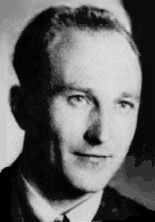Michał Vituška
| Michał Vituška | |
|---|---|
 Michał Vituška | |
| Native name | Міхал Вітушка |
| Born |
5 November 1907 Nesvizh, Russian Empire |
| Died | 27 April 2006 (aged 98) |
| Allegiance |
|
| Rank | General |
| Commands held | Chorny Kot |
| Battles/wars | World War II |
General Michał Vituška (Belarusian: Міхал Вітушка; 5 November 1907 Nesvizh – 27 April 2006)[2] was a Belarusian leader of the Black Cats, a unit of the SS-Jagdverbände, during World War II.[3]
Biography
Michał Vituška was born in the city of Nesvizh (then part of the Russian Empire) and studied in Belarusian gymnasiums in Kletsk, Wilno.[4] He graduated from a university in Prague and the Warsaw University of Technology. In Warsaw Vituška joined the Belarusian Student Movement. Between 1939 and 1940 he served under the Chief of Soviet Police in Nesvizh.[5]
In 1939, after the Soviet invasion of Poland, the territories of West Belarus were annexed by the USSR. The local population remained disaffected towards the Soviet occupants, so when Germany invaded the Soviet Union on June 22, 1941, many people organized around the Belarusian Central Rada, a Belarusian representative council in the Nazi-occupied Belarus, Vituška among them.[4] In August 1941 he became one of the commanders of the Belarusian Self-Defense units formed in the Western part of Belarus. He was also a chief organizer of the Belarusian Auxiliary Police in Minsk. From 1942 to 1943 he organized Belarusian forces in Bryansk, Smolensk and Mogilev. He also became a part of the Belarusian Self-Help and had the rank of a major in the Byelorussian Home Defence. He took part in the 2nd Belarusian congress and beginning in the late summer of 1944 was also the officer of the Dallwitz parachute battalion.[5]
Still, soon some Belarusian national activists including Vituška formed a conspirative Belarusian Independence Party (Беларуская Незалежніцкая Партыя)that was led by Vituška along with Vincent Hadleŭski and Usevalad Rodzka.[6]
Black Cats
Meanwhile, special units (SS-Jagdverbände) of local collaborationists were trained by the Germans to infiltrate the Soviet rear. They were trained in Dahlwitz near Berlin by SS-Standartenführer Otto Skorzeny.[7] The paratroopers came from Reichskommissariat Ostland; and were split into commandos based on the country of origin. As part of the Nazi effort to combat the growing Soviet partisan movement in Belarus during the war, some thirty Belarusians from the espionage and sabotage outfit known as "Čorny Kot" (Black Cat) led by Michał Vituška age 37, were airdropped by the Luftwaffe in late 1944 behind the lines of the Red Army. At that time, the German forces had already been expelled from the present-day Belarus during Operation Bagration.
Black Cats experienced some initial successes due to disorganization in the rear of the Red Army. Other German-trained Belarusian nationalist units also slipped through the Białowieża Forest in 1945.[8] However, the NKVD secret police informants infiltrated these units. As the result, they were ambushed and killed in short order.[9]
The anti-Soviet partisans experienced some initial success due to disorganization in the rear of the Red Army. Vituška became the coordination centre leader of the anti-soviet resistance partisan movement in Belarus. The NKVD had already infiltrated these units, and by 1946 they were neutralized. At the beginning of the 1950s most of the leaders of the resistance movement had to escape to the West. On January 7, 1945,[10] Vituška was supposedly hunted down, captured and executed, although more than sixty years later, his son said that he died in 2006.[2]
Legacy
Vituška is today openly honored by Belarusian nationalists like the youth organization Young Front.[11] On November 5, 2007 activists of the organization were arrested after celebrating the hundredth birthday of Vituška.[12] On March 25, 2014 members of the Young Front visited a demonstration with an banner, featuring Michał Vituška along with Vincent Hadleŭski, Stepan Bandera, Stanisław Bułak-Bałachowicz and Roman Shukhevych bearing the description: "Heroes do not die".[13]
See also
References
- ↑ Дэкрэт аб узнагароджаньні Ордэнам Пагоні, 1950 г.
- 1 2 Міхал Вітушка памёр двойчы (in Belarusian)
- ↑ Perry Biddiscombe: The SS Hunter Battalions. The Hidden History of the Nazi Resistance Movement. Tempus, Stroud 2006, p. 66.
- 1 2 Biography at slounik.org (Belarusian)
- 1 2 Antonio J. Muñoz, Oleg V. Romanko: Hitler's White Russians: Collaboration, Extermination and Anti-partisan Warfare in Byelorussia, 1941-1944, Europa Books 2003, p. 452f.
- ↑ Andrew Wilson: Belarus: The Last European Dictatorship, Yale University Press, New Haven 2012, ISBN 978-0-300-13435-3. p. 108
- ↑ Stephen Dorril (2002). MI6: Inside the Covert World. Belorussia. Simon and Schuster. p. 217. ISBN 0743217780. Retrieved 19 February 2015.
- ↑ Perry Biddiscombe: The SS Hunter Battalions. The Hidden History of the Nazi Resistance Movement. Tempus, Stroud 2006, p. 66.
- ↑ Dudar (March 25, 1999). "Belarusian "Black Cats" of Otto Skorzeny". John Loftus "The Belarus Secret", edited by Nathan Miller, Alfred A. Knopf Inc., New York, 1982. ISBN 0-394-52292-3. Internet Archive. Archived from the original on October 25, 2009. Retrieved 19 February 2015.
- ↑ Нашествие призраков прошлого
- ↑ Міхал Вітушка: ТОП-5 міфаў., mfront.net
- ↑ Niasvizh: Police Detain ‘Young Front’ Activists for Celebrating Vitushka’s Birthday, spring96.org
- ↑ Малады Фронт тлумачыць, каго лічыць героямі, svaboda.mobi]